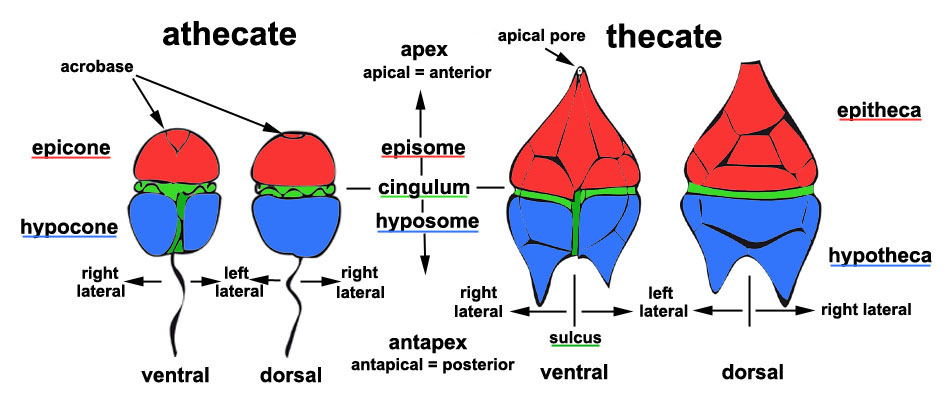Oh my goodness! Unless you are a Tree of Life developer,
you really shouldn't be here. This page is part of our beta test site, where we
develop new features for the ToL, often messing up a thing or two in the
process. Please visit the official version of this page, which is available
here.
Orientation of a Motile Dinoflagellate Cell
Mona Hoppenrath
Motile single dinoflagellate cells have per definition an orientation. This cell orientation needs to be understood to describe the species properly and to understand published descriptions. The cell is divided in an upper part and a lower part separated by the cingulum (transverse furrow). The upper part is generally named episome but could be called epicone in athecate (naked) cells and epitheca in thecate (armoured) cells. Respectively the lower part is the hyposome or hypocone in athecate and hypotheca in thecate cells. The cells are swimming with the apex (the top of the episome) to the front. The bottom of the hyposome is the antapex. Everything above the cingulum is apical or anterior and everything below the cingulum is antapical or posterior. Per definition the cell side with the sulcus (longitudinal furrow) is ventral. The opposite side to ventral (the "venter") is dorsal (the "back"). Having ventral and dorsal, you can also distinguish between a left lateral and right lateral side. Athecate dinoflagellates can have an acrobase (apical groove) at the apex and thecate cells can have an apical pore.

Click on an image to view larger version & data in a new window

Overview of the external morphology and its terminology of athecate and thecate dinoflagellate cells. © Mona Hoppenrath
About This Page
Mona Hoppenrath

Forschungsinstitut Senckenberg, German Centre for Marine Biodiversity Research, Wilhelmshaven, Germany
Correspondence regarding this page should be directed to Mona Hoppenrath at
Page copyright © 2008 Mona Hoppenrath
 Page: Tree of Life
Orientation of a Motile Dinoflagellate Cell
Authored by
Mona Hoppenrath.
The TEXT of this page is licensed under the
Creative Commons Attribution-NonCommercial License - Version 3.0. Note that images and other media
featured on this page are each governed by their own license, and they may or may not be available
for reuse. Click on an image or a media link to access the media data window, which provides the
relevant licensing information. For the general terms and conditions of ToL material reuse and
redistribution, please see the Tree of Life Copyright
Policies.
Page: Tree of Life
Orientation of a Motile Dinoflagellate Cell
Authored by
Mona Hoppenrath.
The TEXT of this page is licensed under the
Creative Commons Attribution-NonCommercial License - Version 3.0. Note that images and other media
featured on this page are each governed by their own license, and they may or may not be available
for reuse. Click on an image or a media link to access the media data window, which provides the
relevant licensing information. For the general terms and conditions of ToL material reuse and
redistribution, please see the Tree of Life Copyright
Policies.






 Go to quick links
Go to quick search
Go to navigation for this section of the ToL site
Go to detailed links for the ToL site
Go to quick links
Go to quick search
Go to navigation for this section of the ToL site
Go to detailed links for the ToL site